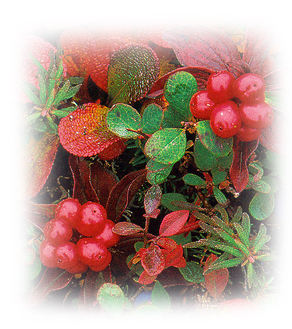Bunchberry, cracker-berry, dwarf cornel, quatre-temps •
|
|
| Cornus canadensis
Cornaceae
Legend and Lore Cornus from the latin: cornu, horn, antler and Canadensis –of Canada; dogwood family. The common name dogwood is from dagwood from the Old English word “dag” meaning dagger. In Europe the dogwood Cornus sanguine was valued for its extremely hard wood used in a variety of handles, including daggers. Horn, antler also refers to the hard wood. Bunchberries are traditionally used in New England Christmas cake to add colour, Canada’s Native people use the berries in pemmican, a mixture of fat, protein and berries that was prepared during the times of plenty to be used during the travel time or during famine. The root was chewed as a precursor to the toothbrush. Medicinally used for colds and colic. In the Garden A low (2-8cm) growing perennial herbaceous subshrub bearing a single whorl of four to six dark green and deeply veined leaves on a short steam. Flowers mid-spring, greenish white then white at maturity forming four large bracts (somewhat like poinsettias), in French “Quatre-temps” refers to the bracts pointing to the four cardinal points. Fruits are coral red drupes in clusters at the stem tip that can last for months, tasting like apples with a crunchy poppy like seed. Prefers shade and will be more vigorous in partial shade, moist and well drained soils. Excellent ground cover; where the leaves turn a beautiful shade of red or burgundy that may persist until the spring. Seeds, cuttings are used for propagation. |
|



